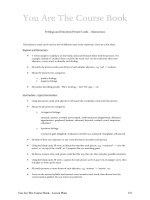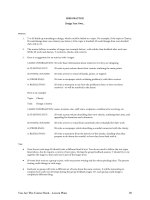yatcb lesson plans improvisation games
Bạn đang xem bản rút gọn của tài liệu. Xem và tải ngay bản đầy đủ của tài liệu tại đây (58.11 KB, 3 trang )
FREE PRACTICE
Improvisation Games
Note: this is a short collection of games to give an example of the kind of thing that you could use during free
practice sessions and warmers. T should add their own games and ask SS to suggest their favourites too.
How can we improvise?
•
•
Say yes! Be open – accept – do not block. Take another person’s idea and modify/develop it; don’t reject it
Practise often; the more you practise something the easier it becomes and the better you become
The Boring Guest:
SS work in pairs. One describes a boring activity for as long as they can while the other tries to make them laugh.
When they laugh, they have lost. Then SS change roles.
Variation: One describes a boring activity in minute detail, e.g. doing the washing up, and the other has to act it out.
Just a Minute:
One SS has to speak for 60 seconds (or 20, 30, 40...) about a given topic without hesitation, repetition, or deviation.
Based upon the popular BBC Radio 4 quiz programme.
Group Story:
SS sit in a circle. One SS says a word and the next continues the sentence with another word. The sentence
continues to be built as SS give one word each. When it comes to a natural end, a SS can say “Full stop!” The next
sentence is built in the same way, and so on. Variation: SS build a story by suggesting one sentence at a time, until
the story concludes. To make it more difficult, SS could agree to include various words and phrases that T elicits
before the activity begins, e.g. a place name, a person’s name, an object, a time of day, etc.
Positive or Negative:
SS work in pairs. One SS is always positive and makes suggestions (e.g. where to go, what to do, what to wear, who
to invite... etc.), while the other is always negative and rejects each one, giving different reasons. Variation: one SS
tries to sell things to the other SS, who always rejects the sales pitch, giving different reasons.
Mime the Description:
One SS describes a film, book, story, place, person, picture etc. and the other SS – or group of SS – have to mime
whatever they say. Variation: whoever is miming has to do it blindfolded!
Draw the Description:
One SS describes a film, book, story, place, person, picture etc. and the other SS – or group of SS – have to draw
whatever they say on the board or in their notebooks. Variation: whoever is drawing has to do it blindfolded!
You Are The Course Book – Lesson Plans
96
Yes or No Replies:
SS work in pairs. One interviews the other. Whatever the first SS says, the other must reply ‘Yes’. Variation: the
other must reply ‘No.’ This can be very funny, with the SS who is interviewing asking increasingly outlandish
questions, while the other has to reply “Yes” or “No”.
What am I?
One SS pretends to be an item, object, place, colour, etc. (linked to a topic) and the others ask yes/no questions to
find out what they are. The SS can only answer yes or no. When somebody guesses correctly, a different SS tries.
What’s my Problem?
One SS has a problem and the others ask yes/no questions to find out what it is. The SS can only answer yes or no.
When somebody guesses correctly, a different SS tries. ‘Problem’ could be ‘job’, ‘hobby’, ‘mood’, ‘nationality’, etc.
Random Sentence Starters
SS work in pairs. They choose a few random sentence starters from p.124 each (e.g. 6-8), then work together to
create a dialogue by putting one of their sentence starters at the beginning of each of their sentences.
Let’s... Yes, and then let’s...!
SS sit in a circle. One starts by saying: “Let’s...” the next continues with, “Yes, and then let’s…” the third continues
with, “Good idea, and then let’s…” and so on. SS continue for as long as they can, making suggestions, accepting
them, then making new suggestions. This is really the basis of improvisation: acceptance-suggestion-acceptancesuggestion... without anyone blocking.
From: Salinsky, Tom, and Frances-White, Deborah. The Improv Handbook. London: Continuum International Publishing Group, 2008.
Paperback. p.59
What’s Just Happened?
An improvisation game. One SS walks into a room in a particular state and the others have to guess what has
happened, e.g. they have won the lottery, damaged T’s car, fallen in love, been in a fight, etc. (present perfect
focus). SS could be given their situation by T (pp.126-127) or another SS, or, preferably, think of it themselves. The
other SS ask yes/no questions to find out the details of what has happened. The SS who walked in has to improvise
the backstory and say what happened, while the other SS react. Variation: a SS walks into the room and says, “I’ve
just made an important decision to…” e.g. quit my job, get married, become a monk, etc. Other SS have to guess
the decision, then ask questions, and generally react to the situation. Variation: T challenges SS to turn a positive
situation into a negative one, and vice versa. For example, if the situation is “I’ve just won the lottery”, SS could
have to say why this is negative for them, while the others try to congratulate them.
SS could also use the cards to discuss life experience with present perfect, e.g. with the question “Have you ever?” followed by each situation. To
make it more improvisational, SS could imagine a character (or famous/fictional person) and answer as that character or person.
I’ve Got a Secret:
One SS leaves the room, and the other SS think of a secret for them; when the SS returns, he or she has to guess it
by asking questions; the others give clues. The others may only be allowed to answer yes or no, or may prefer to
give cryptic answers to make it harder for the SS to guess.
You Are The Course Book – Lesson Plans
97
Describe then Accept Changes:
One SS describes the appearance of something in detail from memory, e.g. a room in their house, their car, a
person, etc.; then others can ask questions and introduce fictional details, which the first SS has to accept and
incorporate into the description, e.g.
Student A:
Student B:
Student A:
“In my bedroom there’s a table next to the door.”
[Making it up] “There’s a green lamp on the table, isn’t there?”
“Er, yes, there is! I bought it when I went travelling in Italy...”
...and so on.
Straight Face:
Tell a joke or a funny story while keeping a straight face. If you laugh, it is somebody else’s turn.
Feelings and Emotions Picture Cards:
Use the Feelings and Emotions Picture Cards and activities (from p.132) to improvise dialogues, stories, and
situations. Or, do the same activities with pictures of people that you have collected from newspapers, magazines,
and catalogues – or from SS’s photographs of their friends and family.
Mood and/or Character Dialogue
Practise reading a dialogue in different moods, e.g. happy, sad, angry, surprised, and so on, then continue the
conversation. SS could use the Mood Cards on p.128 for inspiration, and combine them with the Character Cards
on p.129.
Good News and Bad News
SS work in pairs. One is the optimist and the other the pessimist. The optimist states: “The good news is...” along
with some good news, while the pessimist thinks of something negative to say which is related to the good news:
“But the bad news is...” and so on. For example:
Student A:
Student B:
Student A:
The good news is that I’m going on holiday tomorrow.
The bad news is that it is going to rain tomorrow.
The good news is that I’ve just bought a new umbrella...
...and so on.
SS continue for as long as they can, then change roles. The news could be related to a topic or to their lives, or to
random topics.
Story Arc:
Students have to complete each line (in turn) to complete the story arc:
1.
2.
3.
4.
5.
6.
Once upon a time there was…
And every day…
Until one day…
And because of that… (repeat lines 2-4 as necessary)
Until finally…
And ever since then…
From: Salinsky, Tom, and Frances-White, Deborah. The Improv Handbook (as above).
You Are The Course Book – Lesson Plans
98









